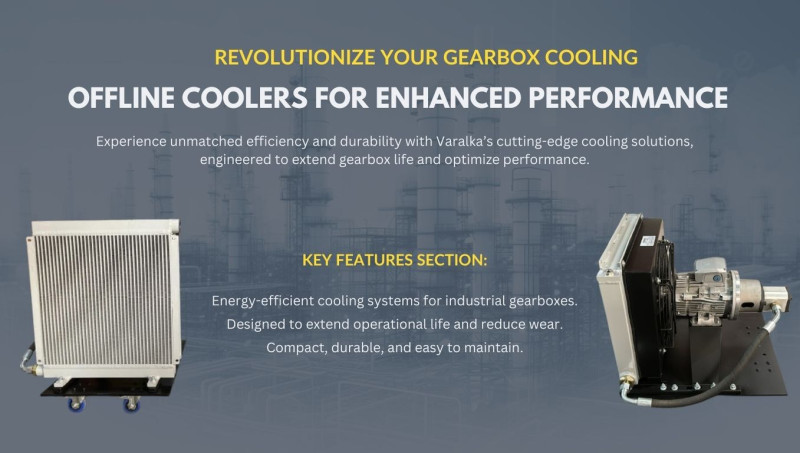Gearboxes are essential components in various industrial applications, from heavy machinery to wind turbines. Maintaining their optimal performance is critical for reducing downtime, preventing failures, and extending their service life. One effective solution to achieve this is by integrating offline coolers into gearbox systems. In this blog, we will explore what offline coolers are, their benefits, and why they are essential for gearbox applications.
Problem Statement: The Challenge of Overheating in High-Torque Gearboxes
High-torque gearboxes are designed to handle substantial loads and transmit power efficiently. However, these gearboxes often face significant heating issues due to the friction generated between gears and bearings. As the torque increases, so does the heat, which can lead to several problems, including oil degradation, component wear, and reduced efficiency. If not addressed, these issues can cause frequent breakdowns and costly downtime.
Traditional cooling methods may not be sufficient to manage the heat generated in high-torque gearboxes, especially in demanding industrial environments. This is where offline coolers come into play, providing a dedicated cooling solution to manage oil temperature and ensure the longevity of the gearbox.
What is an Offline Cooler?
An offline cooler is a dedicated cooling system designed to operate independently of the primary lubrication circuit in a gearbox. Unlike traditional cooling systems that rely on the main oil flow, offline coolers work separately to regulate the oil temperature, ensuring that the gearbox operates within a safe and efficient temperature range.
These coolers are typically equipped with a pump that draws oil from the gearbox, passes it through a heat exchanger to cool it down, and then returns the cooled oil back to the system. This continuous cooling process ensures that the gearbox oil remains clean and at the right temperature, enhancing the overall performance of the machinery.
Why is Cooling Important for Gearboxes?
Gearboxes generate significant heat during operation due to friction and the high-speed movement of gears. If this heat is not properly managed, it can lead to:
- Oil degradation: High temperatures can cause the gearbox oil to break down, reducing its lubricating properties and leading to increased wear and tear.
- Component damage: Excessive heat can damage critical components like bearings, gears, and seals.
- Reduced efficiency: Overheated gearboxes can result in decreased efficiency, leading to higher energy consumption and operational costs.
Benefits of Using Offline Coolers for Gearboxes
Integrating an offline cooler into a gearbox system offers several advantages:
1. Enhanced Oil Quality
Offline coolers help maintain the oil at a stable temperature, preventing it from degrading quickly. This extends the oil’s lifespan and ensures it retains its lubricating properties.
2. Improved Gearbox Performance
By keeping the oil temperature within an optimal range, offline coolers help reduce friction and wear inside the gearbox, leading to smoother operation and improved performance.
3. Reduced Downtime
Overheating is one of the main causes of gearbox failures. An offline cooler can prevent these failures, reducing unplanned downtime and increasing overall productivity.
4. Energy Efficiency
Cooler gearboxes operate more efficiently, consuming less energy. This translates into cost savings and a lower carbon footprint for industrial operations.
5. Easy Maintenance
Offline coolers are relatively easy to maintain. Since they operate independently of the primary lubrication circuit, maintenance can be performed without disrupting the entire system.
Applications of Offline Coolers in Gearboxes
Offline coolers are used in a variety of industrial applications where gearboxes are critical components. Some common applications include:
- Wind turbines: Gearboxes in wind turbines operate under varying loads and environmental conditions. Offline coolers ensure that the gearbox remains cool and functional, even in harsh conditions.
- Marine engines: In marine applications, gearboxes are exposed to continuous operation. Offline coolers help manage the heat generated, ensuring reliable performance.
- Heavy machinery: Industrial equipment such as cranes, excavators, and conveyors benefit from offline coolers by reducing the risk of overheating during prolonged use.
How to Choose the Right Offline Cooler for Your Gearbox
When selecting an offline cooler for a gearbox application, consider the following factors:
- Cooling capacity: Ensure the cooler can handle the heat load generated by the gearbox.
- Oil flow rate: Choose a cooler with a pump that matches the oil flow requirements of your system.
- Size and installation: The cooler should fit within the available space and be easy to install.
- Durability: Look for offline coolers made from high-quality materials that can withstand harsh operating conditions.
- Maintenance requirements: Consider the ease of maintenance to ensure long-term reliability.
Conclusion
Offline coolers are essential components for maintaining the efficiency and longevity of gearboxes in various industrial applications. By regulating oil temperature and ensuring consistent lubrication, these cooling systems help prevent overheating, reduce wear and tear, and improve overall performance.
If you are looking for a reliable solution to keep your gearboxes running smoothly, consider investing in a high-quality offline cooler. It’s a small investment that can yield significant benefits in terms of productivity, energy efficiency, and reduced maintenance costs.
At VARALKA, we offer a wide range of offline coolers and oil cooling solutions tailored to meet the needs of different gearbox applications. Contact us today to learn more about our products and how we can help optimize your industrial equipment.

